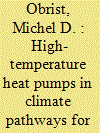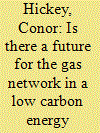| Srl | Item |
| 1 |
ID:
150392


|
|
|
|
|
| Summary/Abstract |
South Africa and specifically its economically dominant province of Gauteng aim to reduce their influence on climate change. Especially the transport sector is seen as one of the key drivers of future greenhouse gas (GHG) emissions. This paper describes the methodology used to combine the application of two models in order to provide a basis for informed policy recommendation for GHG mitigation.
The TEMT model provides real world emission factors adapted to local conditions in Gauteng for numerous vehicle technology concepts. Those data feed into the TIMES-GEECO energy system model which identifies future technology use for different alternative scenarios. Finally, the scenario results are illustrated spatially using a GIS programme.
The results of the scenario analysis show that under implemented policies GHG emissions in Gauteng are likely to increase substantially. Pollutant emissions are currently high as a result of a comparably old vehicle fleet. The spatial display of these results shows where the traffic network is concentrated and the location of so-called emission hot-spots. Energy efficient policies for the transport sector of Gauteng can achieve a significant reduction of emissions and energy consumption. Alternative powertrains and the use of locally produced biofuels can play a significant role in such policies.
|
|
|
|
|
|
|
|
|
|
|
|
|
|
|
|
| 2 |
ID:
191138


|
|
|
|
|
| Summary/Abstract |
To reach the goals of long-term energy and climate policy, the contribution of the industrial sector is important. Upgrading low temperature industrial waste heat using electric high-temperature heat pumps (HTHPs) can improve the overall energy-efficiency and mitigate CO2 emissions by replacing fossil fuels. The pulp and paper and the food and beverage industries use significant quantities of heat up to 200 °C and therefore have a high potential for the application of HTHPs. In order to assess the role of HTHPs, a techno-economic bottom-up cost optimization model is developed building on the Swiss TIMES Energy system Model (STEM). We present an advanced modeling framework including energy and material flows, with a high temporal resolution and a segregation of the temperature level of the process heat. The results show that HTHPs are cost-effective up to a temperature of 150 °C. Switzerland has the economic potential to deploy of about 100 MWth in the pulp and paper industry and 900 MWth in the food and beverage industry by 2050. Incentivizing the exploitation of this significant potential will require very high CO2 prices of several hundred €/tCO2 or additional policies to overcome investment barriers by supporting investment and flexible system-serving operation of heat pumps.
|
|
|
|
|
|
|
|
|
|
|
|
|
|
|
|
| 3 |
ID:
163561


|
|
|
|
|
| Summary/Abstract |
This paper evaluates the potential low carbon opportunities for and challenges to the utilisation and financial performance of Ireland's gas distribution network within a series of low carbon scenarios. There has been a limited amount of academic literature published on the future implications of gas demand on gas networks. This paper takes the unique perspective of assessing the stranded asset risk to a utility operating a gas network in the context of a low carbon energy system. Building on established emissions reduction scenarios, a financial model is developed from an integrated energy system model to understand the financial risks associated with continued investment in gas networks. We find that higher network tariffs are required for consumers in the future to cover network costs, even though gas consumption grows relative to current consumption levels in low carbon scenarios with carbon capture and storage.
|
|
|
|
|
|
|
|
|
|
|
|
|
|
|
|
| 4 |
ID:
109313


|
|
|
|
|
| Publication |
2011.
|
| Summary/Abstract |
Energy policies are often related to the global effort in reducing greenhouse gas emissions through increased use of renewable energies in electricity production. The impact of these policies is usually calculated by energy planning tools. However, the modeling methodologies most currently used are not adequate to simulate long-term scenarios while considering the hourly dynamics of supply and demand.
This paper presents an extension of the TIMES energy planning tool for investment decisions in electricity production that considers seasonal, daily and hourly supply and demand dynamics. The inclusion of these dynamics enables the model to produce more accurate results in what concerns the impact of introducing energy efficiency policies and the increased use of renewable energies.
The model was validated in São Miguel (Azores, Portugal) for the years 2006-2009, where a comparison with real data showed that the model can simulate the supply and demand dynamics. Further, the long-term analysis shows that the inclusion of these dynamics contributes to a better assessment of the renewable energy potential, suggests the postponement of investments in new generation capacity, and demonstrates that using fine time resolution modeling is very valuable for the design of effective policy measures under high renewable penetration energy systems.
|
|
|
|
|
|
|
|
|
|
|
|
|
|
|
|